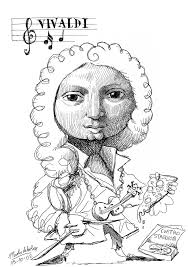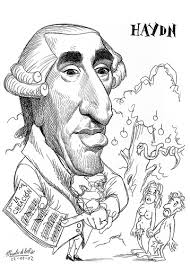 Just about everyone in the Bach family was a great musician but nobody was better the Johann Sebastian. Johann’s mom died when he was nine and his dad a year later. So Johann was shipped off to the little town of Ohrdruf to live with his brother Johann Christoph, who was an organist and a pupil of Johann Pachelbel. Because money was scarce, Johann was sent to the choir school St Michael in Luneberg. The rules stated that the singers had to be the “offspring of poor people, with nothing to live on, but possessing good voices”. He seemed to fit the criteria.
Just about everyone in the Bach family was a great musician but nobody was better the Johann Sebastian. Johann’s mom died when he was nine and his dad a year later. So Johann was shipped off to the little town of Ohrdruf to live with his brother Johann Christoph, who was an organist and a pupil of Johann Pachelbel. Because money was scarce, Johann was sent to the choir school St Michael in Luneberg. The rules stated that the singers had to be the “offspring of poor people, with nothing to live on, but possessing good voices”. He seemed to fit the criteria.
The school paid for his tuition, room and board and gave him candles and firewood. When his voice broke, rumour has it he sang and spoke in octaves for a week. That would have been an interesting effect. Anyway, he was kept busy playing violin, viola and organ.
After Bach had learned all that he could, he asked permission to travel to Lubeck. He wanted to hear the Danish Organist Dietrich Buxtehude. They weren’t terribly keen on the idea but they gave him four weeks off his job as the choir teacher. He walked 200 miles to Lubeck and had a wonderful time. It turns out that Buxtehude was looking at retiring so he offered the gig to Bach, on one condition, he had to marry Buxtehude’s daughter Anna Margreta who was nearly 30. Bach was only 20, however, it seemed reasonably acceptable, considering that’s how Buxtehude got the job in the first place. But alas, Bach had other plans and said, thanks but no thanks. So did Matheson and Handel by the way. It wasn’t the sort of fringe benefit they had in mind.
When Bach returned, the congregation was not very happy with him. He came back with all these fancy ideas about playing hymn tunes with lots of extra notes and ornamentation. They couldn’t find the melody. He was told to cut it out and keep things simply, so he did. Too simple.
It turns out Bach wasn’t interested in Buxtehude’s daughter because he had his eye one someone closer to home – Maria Barbara Bach, his second cousin on this father’s side. She was an orphan living with her aunt and uncle. She was a cute as a button and a lovely soprano. Pretty soon the church authorities noticed that the two of them were spending a lot of time together in the organ loft, alone! So all things considered, they married and moved to Muhlhausen. 14 years later, Maria had died. During this time, Bach and Maria moved around and lot and Bach composed a lot.
After Maria died, Bach married again, this time to Anna Magdalena Wulcken. She was 16 years younger than he, a good singer and copyist. After a while, her handwriting began to look like his. Very handy I say considering he spent a month in prison after angering his boss, Duke Wilhelm Ernst of Saxe-Weimar. So in 1723, Bach and his new wife packed up all their possessions and the kiddies (there were seven by this time) and moved to Leipzig. Bach was very busy at Leipzig but he still managed to compose nearly 300 cantatas, his B Minor Mass and the St Matthew Passion.
In his later years, Bach was nearly blind and his health was declining. An English occulist, John Taylor, attempted surgery on Bach’s eyes bit it did no good. The operation left him completely blind. Suddenly on July 18, 1750, Bach’s eyesight was miraculously restored, but he suffered a stroke and died ten days later. Anna never remarried and tried to struggle along on a measly pension. She died a bag lady in the streets of Leipzig.
In mystical numerology B equals 2, A equals 1, C equals 3 and H equals 8: the sum, as you might guess, is 14. Both 14 and its mirror 41 —the number obtained by adding the numerical value J and S to the computation— were among Bach’s favourite and they are hidden countless times within the notes and musical structure of Bach’s music. Need an example? There are 14 Canons in the Goldberg Variations and 14 Contrapuncti in the Art of Fugue.
 Vivaldi is considered one of the foremost Italian Composers of the Baroque Era. He was famous, well respected and made a comfortable living most of his life, but he died a pauper. That’s the way it goes.
Vivaldi is considered one of the foremost Italian Composers of the Baroque Era. He was famous, well respected and made a comfortable living most of his life, but he died a pauper. That’s the way it goes.
When little Antonio was born, the midwife who delivered him, baptized him right away. She wasn’t sure he’d make it, and wanted to give him a fighting chance at the pearly gates. He did survive, of course, eventhough he was always quite sickly. Vivaldi took 10 years to get through his holy orders and when he did become a fully fledged priest, he hardly ever said mass. He cited his asthma as making it too difficult for him. Some biographers prefer to believe that he was always running off to joint down a musical idea, or that he was high up in the Venetian criminal underworld. You decide what works for you.
Vivaldi was a “ranger” and spent most of his life as a teacher of violin at “Ospedale della Pieta” – a school for orphaned girls. The Pieta was intended exclusively for girls and young women, many of whom were illegitimate offspring of concubines and mistresses of the wealthy and powerful. Most of the music Vivaldi composed was for his pupils at the orphanage. They would give recitals every sunday to standing room only.
In 1713, he turned his hand to Operas, 49 of which survived today. His first opera was “Ottone in Villa” with a libretto by Domenico Lalli (his real name was Sebastino Biancardi, but he change it after leaving Naples accused of embezzlement). He averaged nearly two operas a year, except “Tito Manilo” which he composed in 5 days. He made sure everyone knew this fact. Vivaldi even had the pleasure of composing an opera staring the infamous castrato Luigi Marchesi. Poor Vivaldi had no intention of writing an opera that started with the main character making an entrance on a horse, downhill, singing an aria written by someone else. But he had no choice.
Poor Vivaldi was a victim of identity theft. Nicolas Chédeville, an otherwise uncelebrated musician of the era, fraudulently sold some of his own work as a series of original Vivaldi compositions during the late 1730s. The first of these pieces, “Il Pastor Fido,” would ultimately become Chédeville’s best-known composition. It is still performed to this day—and still, from time to time, incorrectly attributed to Vivaldi.
All in all, he composed about 450 concertos. Most of it lost. However, Turin University musicologist Alberto Gentili was presented with a box of incomplete, unsorted pages from hundreds of Vivaldi’s compositions in the early 20th Century. He began a ten-year investigation to hunt down the remaining pages and place them in their original order. The end result: 319 complete Antonio Vivaldi compositions that had been lost to the world for nearly two centuries.
The explosion of new work from Vivaldi, gave his work a new public debut. It was as if Vivaldi had been born a second time. By the 1950s, his music held a unique place: he was acknowledged by scholars as one of the greatest and most influential classical musicians in history, but he was also seen by the listening public as fresh, mysterious, and unfamiliar. No other composer of similar prominence has experienced that kind of rebirth, and it’s unlikely that any ever will.
 Haydn had neither the flashy individuality of Mozart or the brooding passion of Beethoven. He was more middle management type. He spent a few years struggling to make ends meet as a young man, but once he found that one job which offered him creative scope and financial security, he stayed for 50 years. Haydn was born into a simple peasant family in the little Austrian village of Rohrau, near the border of Hungary.
Haydn had neither the flashy individuality of Mozart or the brooding passion of Beethoven. He was more middle management type. He spent a few years struggling to make ends meet as a young man, but once he found that one job which offered him creative scope and financial security, he stayed for 50 years. Haydn was born into a simple peasant family in the little Austrian village of Rohrau, near the border of Hungary.
His first big break came when he and some fellow buskers serenaded the house of Johann Joseph Kurz, a comedian and pantomime performer. Kurz commissioned Haydn to compose the music for a comic opera “The Crooked Devil”. It was about this time that Haydn fell madly in love with one of his pupils, Therese Keller. Haydn wanted to marry her, but she decided she wanted to become a nun. As a sort of consolation prize, Therese’s father suggested that Haydn could marry her sister, Anna Maria. Too upset to think straight, Haydn said yes. He lived to regret it: Anna was ugly, ill-tempered, and a bad housekeeper. Worst of all, she had no appreciation of his life as a musician. She would use his manuscripts to line cake tins or cut the paper into strips to curl her hair with.
His way of coping – he fooled around. First he fell in love with a singer named Luiga Polzelli. They kept hoping her husband and his wife would die. Her husband did die, but his wife hung on until around 1800 when Haydn was 68. Polzelli, meanwhile, had moved on. Eventually, Haydn got a job as court composer and Kepellmeister to Prince Paul Anton Esterhazy. He stayed in this position for the rest of his life.
Poor Paul Anton didn’t last long. He was replaced by his brother, Nicolaus the Magnificent. Nicolaus played a baryton, which is sort of a cross between a cello and a guitar. Nobody makes them anymore. But if you find one, Haydn wrote about 160 chamber pieces for it.
Nicolaus decided to build a splendid new summer castle in the middle of a swamp. He was fond of duck hunting. “Eszterhaza” was a classy place but the musicians and Haydn hated being stuck in the boondocks. This situation led Haydn to compose one of his best known symphonies – No 45 in F# Minor – known as the “Farewell Symphony”. the joke comes at the end of the final movement, when as the instrumental parts drop away, each player was instructed to snuff out his candle and leave the stage. By the end, there were only two violins playing – Haydn and Tomasini. Nicolaus got the message and everyone packed up and left the very next day.
When Haydn died in 1809, there was a simple funeral since Austria was rather busy being invaded by Napoleon’s troups. A couple of amateur medical students stole Haydn’s head and put the skull in a little black box with a white silk cushion. They wanted to read the bumps on his head.
In 1820, Prince Nicolaus Esterhazy II had the body exhumed. When he found that it had not head, boy was he mad. He finally tracked down the thieves and demanded it back. That had donated Haydn’s skull to the Viennese musical society and gave him some other skull instead. It wasn’t until 1954 that Haydn’s head and body were reunited. Other than that, he was a pretty together kind of guy.
E ither you like Wagner, or you don’t. That about sums it up. Wagnerian Opera represents the highest form of art as a synthesis of music and drama. For others, it’s just fat people shouting at each other in German for what seems like an eternity. Rossini is quoted as saying, “Wagner has good moments, but bad quarter hours.”
ither you like Wagner, or you don’t. That about sums it up. Wagnerian Opera represents the highest form of art as a synthesis of music and drama. For others, it’s just fat people shouting at each other in German for what seems like an eternity. Rossini is quoted as saying, “Wagner has good moments, but bad quarter hours.”
As a boy, Wagner could be troublesome at times. Every couple of nights, he would wake up screaming at the top of his lungs just to let everyone know that he was still around ( at bit like my 16 year old, mostly blind cattle dog). Wagner enrolled at the University of Leipzig, where he majored in drinking and gambling. He didn’t last long at University once he discovered they expected him to attend classes.
The first performance of a Wagner opera took place in Magdeburg in 1836. Das Liebesverbot, based on Shakespeare’s Measure for Measure, was not a rousing success. There were barely two performances. There were barely two performances. On the first night, the leading tenor forgot most of his lines and hid behind a big feather boa, hoping that might help. The second night never really got off the ground at all. The leading soprano’s jealous husband went backstage an punched the second tenor in the nose. When she tried to stop her husband, her hit her too and she fainted.
Wagner’s attitude to marriage was, shall we say, less than exemplary. There always seemed to be some woman whom he found more interesting, for a while at least, than his wife, Minna. Wagner definitely let success to go his head. Most of his final opera, Parsifal, was composed after hours of soaking in a hot tub full of perfume. He was particularly fond of a “pale and delicate shade of pink”. Let’s give the last word to Friedrich Nietzsche: “Is Wagner a human being at all? Is he not rather a disease?”.
Wagner is often credited with inventing leitmotifs – melodies associated with specific characters, events, or themes that can be used to program the audience with subconscious triggers. It’s hard to imagine what film soundtracks would sound like without them. Imagine Star Wars without the Imperial March. The Imperial March, that (transparently Wagnerian) melody triggers fans’ memories of the character’s entire story arc. After you’ve seen the trilogy a few dozen (or hundred) times, the melody recalls, all at once, a powerful monstrous shape and a satanic tempter and a wounded, dying father—invincibility and insidiousness and tragic vulnerability—which gives a depth and complexity to Darth Vader’s scenes that would not otherwise be present.
The thing is, he didn’t invent them —they were already in use by the time he came on the scene—but he was the first composer to use them extensively, and he was the first composer of prominence to make leitmotifs central to his work.
